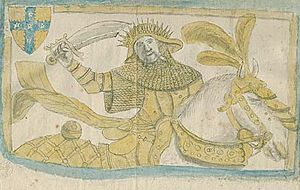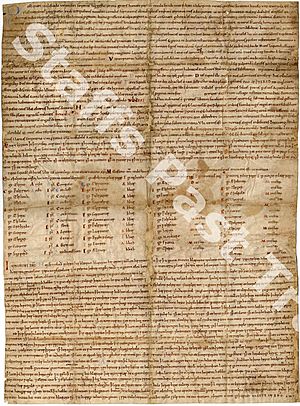Wulfric Spot facts for kids
Quick facts for kids
Wulfric Spot
|
|
|---|---|

An 18th-century pencil sketch of a stained glass window in Abbots Bromley depicting Wulfric, the original held by the William Salt Library, Stafford
|
|
| Died | c. 1004 (on 22 October, according to later tradition) possibly in the battle of Ringmere
|
| Resting place | cloister of Burton Abbey |
| Years active | floruit 980s until death |
| Known for | landed wealth, patronage of Burton Abbey, Anglo-Saxon will |
| Title | thegn (minister, charters), consul and comes (Burton Abbey Chronicle) |
| Children | daughter of unknown name |
| Parent(s) | Wulfrun (mother) |
| Relatives | Ælfhelm of York (brother); Ælfthryth (sister); Wulfric the Black; Ælfgifu of Northampton (niece), Morcar (nephew) |
Wulfric (who died around the year 1004) was an important Anglo-Saxon nobleman. He was also known as Wulfric Spot. His last will, a special document, gives us a lot of information about his time. This was during the rule of King Æthelred the Unready. Wulfric was a big supporter of Burton Abbey, a religious center. The town of Burton on Trent grew up around this abbey. Wulfric might have even started the Benedictine monastery there again.
Contents
Wulfric's Family Connections
Wulfric was one of three known children of a noblewoman named Wulfrun. The city of Wolverhampton is named after her! Wulfric's family was connected to Wulfsige the Black. King Edmund I had given Wulfsige land in Staffordshire. A lot of Wulfric the Black's land later went to Wolverhampton through Wulfrun. Other parts, like lands near Abbots Bromley, went to Wulfric. This makes it possible that Wulfric the Black was Wulfric's grandfather on his mother's side.
Wulfric's brother was Ælfhelm, Ealdorman of York. Ælfhelm was a powerful leader in the north of England from 993 until he was killed in 1006. Ælfhelm was the father of Ælfgifu of Northampton. She later became the first wife of King Cnut. Ælfgifu was the mother of King Svein of Norway and King Harold Harefoot of England. Ælfhelm also had two sons, Wulfheah and Ufegeat. Sadly, they were blinded when their father was killed.
Wulfric also had a sister named Ælfthryth. Her daughter, Ealdgyth, married Morcar. Morcar was killed in 1015 along with his brother Sigeferth. King Æthelred ordered their deaths. It seems Ælfthryth died before Wulfric wrote his will.
Wulfric's nickname, "Spot," might mean he had a mark on his face. Or, it could mean he was a short, heavy person. However, people didn't start calling him "Spot" until the 1200s.
Wulfric's Important Role
A historical record from Burton Abbey calls Wulfric a "consul" and "count" of the Mercians. This might mean he was a very high-ranking official, like an ealdorman. But other older records call him a "minister," which means he was a thegn. A thegn was a nobleman who served the king. His position might have been somewhere between a thegn and an ealdorman, especially in areas with more Viking influence.
We don't know much about Wulfric's daily life. But his will, which King Æthelred approved, shows he was incredibly rich. He owned land in ten different counties in the middle of England. He also had land between the River Ribble and the River Mersey. The land he owned just "between Ribble and Mersey" was worth 145 pounds in 1066. This information comes from the Domesday Book, a famous survey of England.
Wulfric's Family and Gifts
Wulfric seems to have had no sons, or none who lived longer than him, because his will doesn't mention any. He left land near Tamworth to his daughter, whose name we don't know. Wulfric had special rights over these lands. They were "not to be subject to any service nor to any man born." His daughter inherited these special rights.
His god-daughter, his brother, nephews, and niece also received gifts in his will. King Æthelred, as was the custom, received land, money, weapons, and horses. Wulfric also gave large sums of money to archbishops, bishops, abbots, and abbesses across England. A monastery in Tamworth received land too.
Burton Abbey: Wulfric's Main Gift
The main place to benefit from Wulfric's will was the abbey of Byrtun, which is now Burton on Trent. People say there was a monastery at Burton a long time ago, linked to Saint Modwenna. But it seems to have disappeared during the Viking Age. Wulfric probably started the monastery there again. The new abbey was dedicated to Benedict of Nursia and followed the Rule of Saint Benedict.
According to the records of Burton Abbey, Wulfric left the abbey all the land he inherited from his father. Besides the large amount of land he gave to Burton in his will, Wulfric also made sure the new abbey would have powerful friends. This was common for noble people who started monasteries. The abbey was meant to pray for his soul and his mother's soul. He gave extra land to Ælfric of Abingdon, the Archbishop of Canterbury. The understanding was that Ælfric would be a friend and helper to the monks. Wulfric also wanted the king to be involved. He gave his ownership rights to King Æthelred. In return, the king agreed to be the lord and protector of Burton Abbey.
When Wulfric Died
Some later records say Wulfric died as late as 1010. And some people have read John of Worcester's chronicle to mean he died at the battle of Ringmere in that year. However, he most likely died between 1002, when he started his will, and 1004. That's when King Æthelred issued his official document approving the will. Wulfric was buried in the cloister of Burton Abbey, next to his wife. Later, Burton Abbey would remember his death on October 22nd each year.


